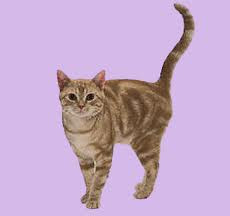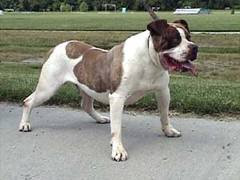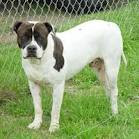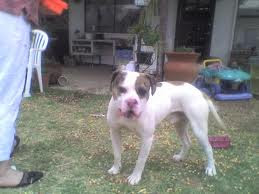Aliases: Boerboel, South African Mastiff, Boer Dog
Description
The African Boerboel is often a quite significant, muscular and impressive hunting breed. They may be often confused for a cross in between a Mastiff plus a Bulldog, nevertheless they are a unique breed which has been created in Africa as a protection and operating dog. In this breed males are distinctly masculine in appearance as the females are smaller, slighter and must be definitely female in all elements.
The African Boerboel is incredibly distinctive in look. The head is pretty square in shape using a short, thick muzzle and wide huge head. The skull is somewhat flat in between the high set ears and there is a quit which is noticeable but not sharp. The ears are triangular and folded, held extremely close to the head. The eyes are horizontal in orientation and may be any color of brown that's in keeping using the coat color. The skin about the eyes really should be dark no matter the eye color. The location among the eyes is nicely filled and solid in appearance, as are the noticeable cheeks. The dogs may possibly or may perhaps not possess a black mask that covers the muzzle as well as the leading lip. The top rated lip is somewhat fleshy and thick in appearance but must not hang down over the lower jaw. The nose is black with properly developed nostrils. The head is among the most distinguishing in the
African Boerboel breed.

The neck of the
African Boerboel is arched and muscular, adding for the breed's look of strength and protection. The shoulders in the dog are extremely nicely developed and strong, with the neck positioned high on the shoulders. The chest is deep and broad, flowing into a well developed rib cage and a sturdy, but not chunky or disproportionately heavy searching physique. The front legs are absolutely straight when viewed from the side or the front and finish in thick padded, ball-shaped feet.
The best line is really straight with out any noticeable sloping. The back is moderately lengthy but balanced in appearance. The hindquarters are slightly sloping towards the high set tail. The tail is traditionally docked for the first 3 joints, but may perhaps also be left lengthy and natural, in which case it curves up at the hock. The back legs are extremely powerful with heavy muscling which is prevalent in the Mastiff breeds. The legs need to be nicely bent and carried under the hindquarters and as opposed to the front legs they need to not be straight.
The African Boerboel must move with purpose as well as a "buoyant" step. They have a fluid and athletic gait, not a heavy or shuffling gait. Their joints are well created and not loose or bulky. They don't have the heavy wrinkles or deep folds of skin observed on many in the Mastiff breeds, however there is going to be slight wrinkling in the thick skin on the brow.
Coat Description
The coat of
the African Boerboel is uniformly short, reasonably coarse and dense. It is simple to care for and needs really little grooming or bathing on a regular basis.
History
The African Boerboel has developed from several different breeds being crossed using the significant Molusses sort dogs brought by the Dutch all through distinctive regions in Africa. The original breed of dog brought to the Cape of
Africa by Jan van Riebeeck in 1652 was generally known as a bullenbijter, and is considered to be a Mastiff sort dog even though not as substantial as some of the Mastiffs now observed. This dog then bred with the neighborhood dogs, producing quite a few various varieties of hardy and powerful dogs that practically had to survive on their own.
In 1820 when the English came to Africa they also brought significant, mastiff sort dogs along with bulldogs. These dogs had been bred with all the already current mastiff sorts. It is known that De Beers mining business brought champion line Mastiffs to Africa to work as guard dogs within the diamond mines, and they were crossed using the very best in the nearby breeds. The English Bulldog and Bull Mastiff are viewed as crucial bloodlines inside the improvement with the breed.
At present
the African Boerboel is bred worldwide. They've to pass wellness tests along with be vet checked before they can be registered with all the South African Boerboel Breeders Association. This Association was formed within the 1980s to prevent the continued crossbreeding with the African Boerboel that was resulting inside a decrease in the quantity of actual African Boerboels, even in Africa.
Temperament
The African Boerboel can be a bit of a study in opposites. As a fierce and loyal watchdog they will bark and loudly announce strangers and strange animals inside the area, nonetheless they'll promptly study who is buddy and welcome them into the home once they have already been introduced. The African Boerboel is also a guard dog, making use of their size and strength to defend their property and household with as considerably aggression and physical action as expected. They may be incredibly protective of their yard and residence and care has to be taken to help keep these dogs securely within a fence, as they'll expand their area to defend should really they get out from the fence or yard.
The African Boerboel is a extremely loving loved ones dog. They certainly enjoy spending time using the family. Regardless of their aggression towards strangers the African Boerboel will play and romp with everybody within the household and are specially fantastic with kids. They may be incredibly tolerant of even rough play with children and their large size makes them good companions for kids of all ages. The African Boerboel is exceptionally gentle with younger young children even though as with all dogs young kids must never ever be left alone unsupervised. They also have a tendency to be pretty accepting of other pets such as dogs, cats and even other small pets and livestock. Proper socialization is key for these dogs to help them understand how you can differentiate between possible dangers and friendly guests.
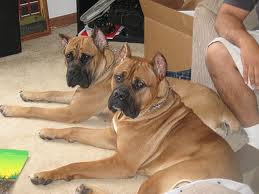
The African Boerboel will generally be somewhat standoffish with new folks, at the very least until they understand that they may be to be viewed as a "friend". This really is pretty essential if the dogs should be cared for if the family has to leave or if they have to be kenneled. Make sure that this breed has time to obtain to know their caregiver before leaving them with somebody other than a family member.
Health Challenges
The African Boerboel is really a really wholesome breed because of the selective Breeding in the original dogs in Africa. Also the African Boerboel has largely had to survive as a breed devoid of veterinary care or specialized remedies, providing a sort of natural selection course of action. You'll find two diverse conditions that may perhaps be problematic in the breed though they are not fatal. The initial condition occurs only in females and is VH or vaginal hyperplasia. This condition is genetic and happens in distinctive grades or levels of severity. Any female with abnormal tissue improvement with the vaginal area ought to not be made use of in breeding programs. The second genetic situation which is discovered within the breed is common in most dog breeds and is found in both males and females. Canine hip dysplasia or CHD and also elbow dysplasia may be checked by vet examination and must be completed before the dog is utilised inside a breeding system.
Grooming
The short, dense and thick coat in the African Boerboel is simple to care for. They're able to be groomed once or twice per week applying a heavy pin brush or stiff bristle brush. Regular grooming both removes dead hair from the coat as well as massages the skin, permitting for elevated circulation. The coat can also be groomed applying a grooming mitt that is certainly quick for even youngsters to utilize to assist with all the grooming routine.
Through the grooming routine
the African Boerboel really should be carefully checked for any signs of fleas or ticks should they be present within the location. Fleas are often very first noted by smaller, dried blood flecks in the coat subsequent towards the skin which might be known as "flea dirt". The owner may possibly also notice the dog licking, scratching or rubbing at the coat. Ticks are blood-sucking insects which will attach themselves for the skin of the dog, generally in locations which include the inner legs, ears and around the lower jaw. Fleas is often treated with monthly topical applications, flea powders and flea collars and ticks may be removed using the fingers or with tick pullers, similar in appearance to tweezers.
The African Boerboel can also benefit from routine dental care. Just like with humans, tartar and plaque can make up on a dog's teeth, resulting in early tooth loss, poor breath and even infections within the mouth. Brushing the African Boerboel's teeth using a finger sleeve or specially developed dog toothbrush and also dog toothpaste will aid reduce tooth decay and stop the will need for costly tooth de-scaling procedures.
Bathing the African Boerboel may be carried out whenever necessary using dog excellent shampoo and following having a conditioner. Stay away from over bathing as this could result in the hair to dry out along with the skin to grow to be dry and flaky. Some African Boerboel may well also have an allergic reaction to some shampoos and conditioners, even specialized dog items. In these instances an oatmeal shampoo may perhaps assist soothe and clean the skin with out any irritation.
The nails of the African Boerboel are pretty challenging and durable and with standard exercising on difficult surface the nails must remain trimmed naturally. If they require trimming a set of slotted scissor style trimmers or guillotine style trimmers are by far the most productive. Keep away from employing any sort of human nail clippers as this could trigger the nails to shatter and splinter.
Workout
The African Boerboel, despite its significant size, doesn't demand an excellent deal of specialized exercise. They may be very good at exercising themselves if they've a large, fenced yard as they're going to patrol the region, making certain that almost everything is secure. They play and interact with other dogs which can be companions, supplying additional exercise devoid of any effort on the element of the owner.
The African Boerboel is a superb walking and jogging companion. They adore to go with household members and are normally properly behaved when out with the yard provided they may be properly trained and socialized. As with all substantial breeds, in particular those which are protective, it is actually incredibly critical to ensure that the dog is completely under control all the time. They're able to be intimidating but their calm behavior when people get to know them will swiftly put people today at ease.
A preferred pastime in the African Boerboel is fetching and playing with the youngsters or adults within the household. They enjoy to invest extended periods of time chasing a ball or stick and bringing it back. A naturally affectionate dog the African Boerboel is usually willing to complete whatever the household enjoys delivering the dog is involved. They do travel nicely though they do take up a sizable region of a vehicle.
As
African Boerboel mature they turn out to be much less active general, so it can be important to ensure that they obtain structured, typical workout is the owner notices they may be staying inactive outdoors or are gaining weight without having any modifications in food or feeding habits. Regular workout will support the African Boerboel lead a wholesome and happy life.
Instruction
The African Boerboel is an intelligent dog that is really eager to work using the owner. They do have the tendency to try to dominate the owner until a hierarchy is created. These dogs should understand as puppies that the owner will be the boss, as opposed to allowing the dog to believe that they're making the decisions about what he or she will do. This doesn't mean that the owner has to become mean or harsh using the puppy, rather they ought to be firm and consistent and stop the dog from developing any poor habits for example ignoring commands or "doing their very own thing".
The sheer size and weight with the African Boerboel combined with its natural protectiveness and guard dog tendencies suggests that the African Boerboel should be under control all the time. An untrained or poorly trained African Boerboel is actually a potentially dangerous animal if it ever gets out from the yard or fenced location. Obedience training is recommended at an incredibly early age and socialization really should be a important component with the education.
Because this breed can be a massive dog and does possess a tendency to become dominant it is not recommended as a first dog to get a family. In the event you don't have knowledge in working with dominant varieties of dogs a African Boerboel from a rescue that is already trained and socialized might be an incredible selection as opposed to trying to train and manage a puppy by way of the complicated teen years.
The African Boerboel will not be typically an issue barker. They're able to tolerate becoming in a kennel for short periods of time but might become prone to chewing, barking or digging if confined inside a smaller space for extended periods of time. The African Boerboel does finest in training with a mixture of physical exercise and education instead of just set instruction times. Allowing for play time and enjoyable time throughout coaching aids with all the bonding process together with allows the dog to break the focus into shorter, more concentrated instances.
Life Span ;12-15 years
Litter Size:7-12 puppies per litter
Group:Mastiff
Color:reddish brown, cream, all shades of brindle, tawny with or without a black mask with some white on chest acceptable.
Hair Length:Short
Size:Extra Large
Shedding:Moderate Shed
Male Height:25-28 inches (64-70 cm)
Male Weight:154-200 pounds (70 and 90 kg)
Female Height:23-25.5 inches (59-65 cm)
Female Weight:154-200 pounds (70 and 90 kg)
Living Area:The African Boerboel does best with a large fenced yard and room to move and exercise.
Space and Physical exercise
Should you be considering adding a boerboel for your family or already personal a boerboel and are thinking of moving (to a smaller home), bear in mind this - bored boerboels are destructive boerboels and a 150 lbs, lion-fighting dog can do plenty of harm. While far more suitable for large yards, Boerboels are adaptable and may live in tiny environments as long as they receive regular physical exercise and also a large amount of focus. Whatever the quantity of space readily available, they have to have lots of physical and mental workout.[2] The Boerboel might be exercised in a substantial yard with adequate space to run and play, but at a minimum this kind of dog requirements to become taken on a lengthy walk each and every day.
Breeding & Registration
Organizations
In 1990, when the Boerboel breed was in danger of becoming extinct, a group of fanciers, the South African Boerboel Breeders’ Association (SABT), started looking for eligible South African dogs to use as a breeding base.[2] Of the hundreds of dogs found, 72 were evaluated and registered. A development register was also maintained for several years to widen the gene pool.
The Kennel Union of South Africa (KUSA), which is the FCI recognized South African authority on breed standards and pedigrees has recognized the Boerboel and given it full breed status. Despite the fact that the SABT was the first breed organization founded for the Boerboel, many other Boerboel breed-specific organizations now exist. The Boerboel is not a breed recognized by the UKC or Irish Kennel Club.
Boerboels may be registered at birth with one or much more breeders' associations. Here are a few: the South African Boerboel Breeders' Association (SABT), Boerboel International (BI), World Wide Boerboels (WWB), the Elite Boerboel Breeders' Association of Southern Africa (EBBASA), or the Kennel Union of South Africa (KUSA).
In order to be registered, a Boerboel must have its birth recorded as having been bred from registered parents and/or must pass an appraisal by a qualified assessor.
Breed Standard
Like other dog breeds, the boerboel has a breed standard. Unfortunately, the exact specifications of the boerboel's breed standard vary depending on the registry.There are, however, several features that are undisputed.
"Type, conformation, functional efficiency and mentality are equally important in the evaluation of the Boerboel as a whole. The aim with the Breed Standard is to provide clear guidelines for breeders and judges to promote a singular vision of the ideal Boerboel."
The Boerboel is a sizable dog with well-developed and well-defined musculature. The profile of his head and body is "blocky." His movement is naturally powerful and graceful, despite his size. His grace and confidence create a majestic impression.He must not exhibit any fearful, shy, overly-submissive, threatening, or aggressive behaviors, but needs to become obedient and responsive to his handler. Females are noticeably smaller and less-muscled, but should still exhibit musculature and give the impression of strength and confidence. (See sexual dimorphism)
The head is impressive plus a distinctive feature of the breed. Any eye color other than brown is considered a minor fault, except blue which is a major (disqualifying) fault. Their expression should always be confident, intelligent, or alert (or a combination, thereof).
The body is blocky, muscular, and solid. The chest is broad and deep with well-developed pectoral muscles. The back, broad and straight. All joints must appear sound (sturdy and well-attached to the body), and must actually be so when the dog is physically examined. All parts of the body should meet and connect smoothly and each area should flow naturally into the next (ex. head to neck to chest).
There should be profuse pigmentation on the skin (and surrounding hair) of : the lips, palate, eyes, nose, paw pads, toenails, anus, and genitals. Only the black, eumelanin pigmentation is acceptable. It is only acceptable for a dog to possess a lot more than a smaller amount of pink or salmon-colored skin, if the dog also has white marks, especially on the head.
The legs are strong-boned, sturdy, and muscular. The paws must have curved, black nails and tough, black pads. There should be hair between the toes. The legs, paws, metatarsus, stifles, and hocks should point straight up (Leg,Paw,Meta.), straight forward (stif.), and straight backward (hock).
The tail should be thick, hairy, and proud. If the tail is docked, it must be at the 3rd or 4th caudal vertebra.
The ideal height of a male boerboel is 66 cm (26.5 in), along with a female is 61 cm (24.5 in). Males shorter than 60 cm (24 in), and females shorter than 55 cm (22 in) may not compete. Height is measured at the withers.
In the show ring,
the Boerboel should appear confident and fearless. It should be easily controlled by the handler, however protective behavior of its handler directed towards judges is permitted.
Some automatic disqualifications are severe underbite or overbite, blue eyes, excessive amounts of pink skin, overly aggressive behavior, small head, insufficient musculature, abnormal and/or undescended testicles, asymmetric form, too short, a weak, unsound, clumsy, or plodding gait, any obvious physical or behavioral abnormality, and any trait that jeopardize the physical functionality of the dog or would severely hinder or prevent the dog from guarding and protecting.
How to Start
For the average boerboel owner thinking of competitively showing his dogs or wanting to breed dogs that conform to the breed's standard, it is important to don't forget that most professional breeders only sell their pet-quality puppies and either keep their show/breeding-quality puppies for themselves or sell them at a higher price (usually to other breeders). Determined, owners should consult the dog's original breeder, if possible. Other resources are local boerboel breed-specific, molosser-specific, or mastiff-specific breeders and rescue groups. Many breed-specific rescue groups leave their contact information with local animal shelters and veterinarian offices. Also, keep in mind that the average house pet will not contain sufficient muscle mass (and perhaps too much body fat) for dog show breed standard without an exercise routine.





